Yes
But Is It Art?
by Heather Leitch
Computer technology has been seen as a threat by many artists, but Marcus Badgley, Darrel Anderson and Jon Fordyce have embraced the new technology and have shown that the computer can be as much a tool of the artist as a brush or chisel.
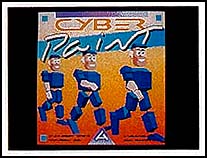 |
| In his more serious moments, Marcus Badgley operates Gravity Design, a San Francisco graphic design studio. Badgley designed the box art for the Fall 1988 Antic Software line, including this pro- posed new box for Cyber Paint. |
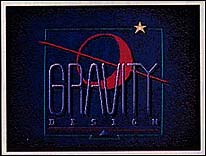 |
| This logo was executed by Marcus Badgley (below) on an ST using Spectrum 512/- Unispec for Badgley's own San Francisco graphic design company. |
A cross between Smurfs and California Raisins, Beschnoones could be a merchandiser's dream (if they were so inclined), but they're hard to find. These colorful creatures live in the country Poony on the planet Universillion. Beschnoones are the main inhabitants of the planet and subsist on gourmet bubbles put out by flying bubble makers called Gourmet Bubble Bumpers. But sometimes their mortal enemies, the Phalangers, creatures that resemble giant hands, follow the bubble makers around and quite literally burst their bubbles. This is bad news for our friends the Beschnoones, because then there's a famine. Beschnoones are basically peaceful creatures, unlike the evil Mutants, beings that resulted from humans crossbreeding with plants. The Mutants are very violent.
Actually, the Beschnoones and their neighbors live in the Atari ST of graphic designer Marcus Badgley. But they can be brought to life in bright, flashing computer color with the click of a mouse. The ST's glowing neon colors brought out the cartoonist in Badgley. The Beschnoones and their fellow inhabitants, the Famn Bo and Booder Ho, spring out of the computer terminal, giving more of a slide show than computer graphic effect.
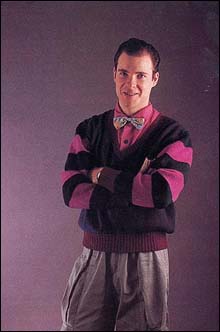 |
"I scanned my cartoon world into the computer because the colors are so bright. Its like working with neon," says Badgley. "I'm scanning a 144-frame animation sequence into the computer now."
The ST is an integral part of the design process for Badgley, as it is for many other artists. Badgley has used an ST since 1985 for everything from designing corporate logos to tending to his San Francisco company Gravity Design's business. "I like to do a little of everything," says Badgley. "I'd like to start animating the Beschnoone world."
Artists like Badgley use the ST as another design tool, to supplement rather than replace paintbrushes and sketch pads. Along with giving the citizens of Universillion a place to live, the ST enables Badgley to view different color schemes and backgrounds for company logos, a mainstay for his graphic design. Badgley switches back and forth between the Atari and the drawing board in creating these designs.
The initial design is still easier for him to sketch by hand. But after scanning the design into the computer, Badgley can alter the design or change the color without having to redraw and recolor the entire graphic. As in writing, the computer lets graphic designers take risks, such as experimenting with bright colors in a new logo for San Francisco-based Just Desserts, as Badgley is doing. He can also experiment with the structure of business cards and logos. "Its easy to move the logo around when designing company stationery," he says.
Using the ST's graphic capabilities, Badgley also created a tutorial on how to draw for the not-so-artistically inclined. The program starts with a series of concentric circles. Gradually one circle becomes the head, another becomes the nose, then eyes.
For Badgley, some of the most useful applications of the ST have been for more mundane business tasks. Among the programs he uses for his business are Data Manager for mailings; Word Writer ST for word processing; VIP Professional, a spreadsheet; and Timeworks Publisher ST to help with newsletters. By putting his bookkeeping and mailing lists on his database, he is freed up for more creative work. "I actually use my computer as much or more to help out with the other aspects of running the business," says Badgley.
Darrel Anderson
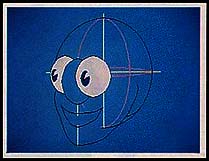 |
| Start with a circle, end up with who knows what. This is one step from Marcus Badg- ley's upcoming START article on ST car- tooning. |
Carrying on in the science fiction genre, artist Darrel Anderson finds the Atari ST useful for illustrations such as those that grace the covers of the Venus Prime Series of science fiction books. Anderson sketched a series of technical drawings to illustrate the high-tech spacecrafts found in the book. (Anderson's work is at the back of the book. He didn't design the voluptuous heroine emerging from a spaceship on the cover.)
 |
| Marcus Badgley mixes his ST graphic design work with off-hour whimsy. This is the title screen from his epic cartoon- in-the-making, "Universillion." |
He's also done illustration for children's books. For a collection of glow-in-the-dark children's books called Night Lights, Anderson used a 3D modeling program to set up illustrations for a book based on Ray Bradbury's story "Fever Dreams".
"I built a very simple model to obtain interesting camera angles," said Anderson. "I would then print images of it, simple line drawings. The story itself is pretty scary. I was surprised they included it in a children's book."
Anderson has been incorporating Ataris into his art for two and a half years. This began when a client in New York sent him an Atari 800 to do some on-screen art for interactive role playing games. He feels one of the main advantages of the ST is the Cyber Studio series of CAD software. "For this level of machine, it's the best CAD package available," he says. "Particularly with the easy interface. You don't want the machine to get in the way."
 |
| Darrel Anderson has long been known for his spectacular ST art. This sketch is one he did for "Hide and Seek," the third book in the "Venus Prime" series of science fiction books. |
Jon Fordyce
Sculptor Jon Fordyce uses the ST to help him do mock-ups of sculptures before he starts building them. This is especially useful since he works with such unforgiving materials as steel pipes and steel sheets. Fordyce first started using the ST after receiving an artistic commission to create a monumental sculpture at Case Western Reserve University in Ohio. In addition to using the computer as a tool, Fordyce also incorporated it into the theme and artistic process for the commission. He believes that the computer is the most significant gift of the twentieth century, bringing with it both increased knowledge and understanding and the ability to destroy us through military applications.
"I decided that the concept of the piece should be the computer with a capital C," he says. "I wanted to create it out of heavy gauge stainless steel so it would last for thousands of years as a symbol to our idea."
Fordyce likes to experiment with the sequence of his designs. Sometimes he'll do a 3D mock-up of a sculpture first, then build it; sometimes he modifies it on his computer halfway through. Since Fordyce works with heavy metals, the computer image is a little more malleable than the real image. For a four-part series titled the "grid series," Fordyce actually incorporated the Atari into the sequence of his sculptures. The grid series' theme centers on, as Fordyce saw it, the limitation of the computer versus the spontaneity of metal (which is the opposite of what would seem to be true).
 |
| Jon Fordyce uses the ST as a design tool for his sculp- ture. This work, Mandala in Transformation I, is one of a series Fordyce produced using Antic Software's CAD-3D to explore three-dimensional design concepts. |
"This brings up a dilemma," says Fordyce. "How do you bring the geometric limitation of computer graphics to the spontaneity and organic qualities inherent in forging red-hot metals?"
Working with steel also necessitates working outdoors, so being able to do the lion's share of the designing in the warmth of his home is an advantage during cold Ohio winters. He used CAD software to design the sculptures. The first sculpture in the four-part series was the Mandala in Transformation, which was designed on the computer first, then worked on outside.
"As I was doing the sculpture, I was consciously open to altering the design for some spontaneity," he says. "I began to develop a visual concept of the piece and reversed the process."
The second in the series, Mandala in Transformation II, was altered halfway through on the computer. For the third, Caregiver, Fordyce forged the sculpture entirely by hand, then went back and designed it on the Atari. Finally, the fourth, Grasp For Life, was done completely by hand.
"I came full circle," he said. "I started with total CAD, then worked my way back."
Fordyce is very involved with the whole process of the artist and the computer, and is putting together a video that will introduce a panel of artists to discuss the topic of sculpture and computers.
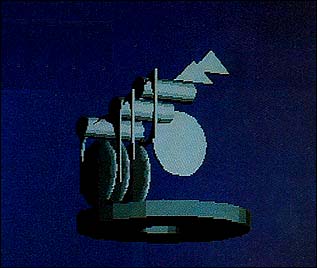 |
| Mandala in Transformation I as seen on the ST's screen. |
"I have several of the world's most famous sculptors from all over the United States and Canada," he says.
Like Anderson and Badgley, Fordyce counts among the Atari ST's assets its affordability and the flexibility and ease-of-use of the Cyber series. "It is the easiest to use, and blending 3D graphics with color is easy on the ST," he says. "It brings meaningful 3D graphics to anyone who wants to use it. The possibilities are almost limitless."
One limitless opportunity involves animating a stainless steel sculpture. Something about that 3D imaging just brings out the cartoonist in these artists. Fordyce says, "There's never enough time to do everything I have ideas for."
Heather Leitch is a San Francisco-based business, high-tech and feature writer. This is her first publication in START.